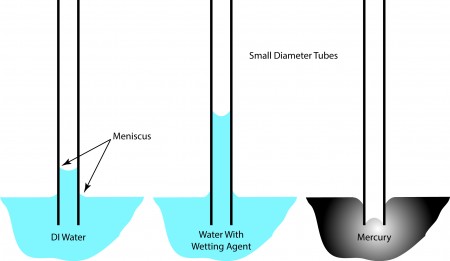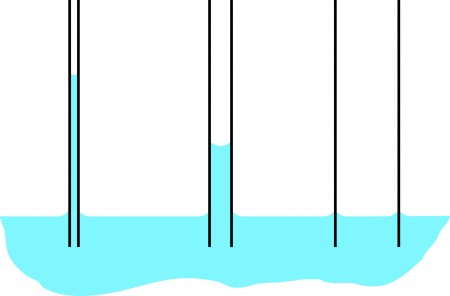In the process of parts cleaning, capillary flow can be our friend or our enemy – sometimes both at the same time. So let’s take a minute or two to understand this interesting phenomenon.
Capillary flow is a property that is exhibited when liquids spontaneously penetrate narrow passageways. The classic example of a capillary (narrow passageway) is a small internal diameter tube. The following illustration demonstrates how three different liquids might respond in a capillary space.

The flow of liquid into a capillary space is spontaneous and occurs without pressure, vacuum or any other outside influence. The height (or depth) of penetration can, of course, be affected by pressure or vacuum but without them, the degree of penetration in similar capillary spaces is related most directly to the surface tension and specific gravity of the liquid. The meniscus formed at the point where the liquid contacts the surface of the capillary space is analogous to the contact angle measurement for surface tension. Contact angle was discussed in previous blogs as both an indicator of cleanliness (if the liquid is held constant) or as a measure of surface tension of a liquid (if the contact surface is maintained constant).
Although we often think of capillaries as tubes, the same phenomenon will occur wherever there are closely spaced surfaces of any geometry including flat plates or more complex shapes like screw threads in contact with a threaded fastener or tapped hole.

The degree of capillary penetration is also directly related to the dimension of the capillary space or gap. A larger capillary gap results in less penetration. Once a specific spacing is exceeded (depending on the surface activity of the capillary walls and the surface tension of the liquid), there will be no noticeable spontaneous penetration into a capillary space although the meniscus effect will still be evident where the liquid and surfaces forming the capillary space meet.
Note – Capillary flow is also commonly referred to as “wicking” as it is this effect which causes liquids to rise in the wick of an oil lamp or candle. Liquid may also “wick” in porous solids.
In cleaning, capillary flow results in difficulties in both rinsing and drying. Once liquid has entered a capillary space (by overcoming gravity) the only way to remove it is evaporation or use of mechanical means such as high pressure air or centrifugal force. The liquid will not just “drain” out.
The purpose of this blog is not to suggest ways to overcome the effects of capillary flow but, rather, to make the reader aware that the effect exists any time small passageways are encountered. The result may be inconsequential in some instances but in others is a means for real concern.
– FJF –



 English
English Spanish
Spanish Chinese
Chinese Canada
Canada Mexico
Mexico United Kingdom
United Kingdom




2 comments on “Capillary Flow”
Would anyone be able to recommend information or sources of rust inhibitors and wetting agents that might work as “ad-ins” to an existing (off-the-shelf) cleaning solution?
Reason for the Rust inhibitor: We have a parts washer tank/piping that is not completely S. Steel and can produce some rust in the chemistry over time.
Reason for the wetting agent: We consistently have issues with incomplete cleaning of blind holes in our small contacts. I am hoping that as spotlighted in John’s blog here, that maybe a wetting agent would lessen that capillary action inside any blind holes and allow for better flushing of cutting oils and chips from the I.D’s of our parts using only mechanical agitation as we don’t have ultrasonics….Any suggestions or comments would be appreciated.
happy to see you back, John